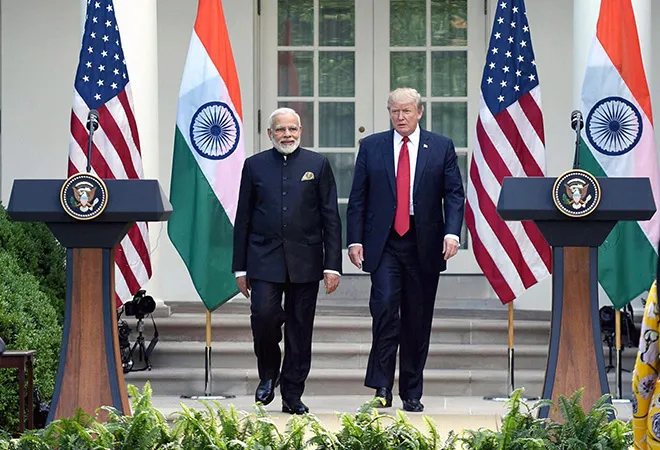Diplomacy is usually a careful, calibrated exercise. Risks and sudden moves are few and far between. Given this, the Narendra Modi government's decision to boycott the Belt and Road Initiative (BRI) Forum in China constitutes one of the three biggest Indian foreign policy risks in recent memory.
The previous two were the decision to back the liberation of Bangladesh, even if it meant conflict with Pakistan, and the nuclear tests of 1998. In the end, both those risks worked out well. The moral principle of India's stand in 1971 won it international validation and military success, and signalled Indira Gandhi's finest hour.
On the other hand, Pokhran 2 and the formal declaration of India's nuclear weapon forced the world to confront the reality of India as a responsible nuclear power. After a period of ostracism, it forced an engagement with India and led to a phase of modern diplomacy.
The boycott of the BRI Forum, the formal statement punching holes into the viability and logic of the farrago of projects known as One Belt, One Road (OBOR), and the refusal to line up for Emperor Xi Jinping's Beijing Durbar constitutes the strongest Indian challenge to China in a long, long time.
Frankly, India had no alternative to refusing to travel for the forum, and to treating BRI/OBOR as a strategic threat to its own legitimate aspirations.
How did the Modi-Xi relationship come to this pass? Modi came to office in 2014 with a China that saw itself at the zenith of its economic and composite power. In 2000, about when the previous BJP government was inaugurated, China's GDP was double India’s GDP. By 2014, it was close to five times India's. Between 2008 — when the financial crisis left the West crippled — and 2014, India's GDP grew 50 per cent; China's grew 250 per cent. This was the legacy Modi was handed down.
How did he respond? First, he sought to enhance market access for Chinese companies and investors, which had been denied by suspicions on national security grounds. This did work to some degree and Chinese investment has grown.
Yet, the bet that this would create political leverage for India within the Chinese system has failed. Neither have the Chinese shown fair-mindedness in removing non-tariff barriers for those commodities and services India can export: pharmaceutical drugs, certain types of meat and dairy products, and IT services.
Despite promises, the Chinese wall has remained impenetrable — even as the Chinese import Indian items through third countries, or offer concessions for similar imports from other nations. The recent beef import concessions to the US are a case in point.
Second, India has had some success in weaning away neighbouring countries from Chinese influence. While Beijing's proxies and constituencies remain in place across South Asia, India is better positioned in Sri Lanka, Bangladesh and even Nepal and Myanmar than it was three years ago.
In the context of the Bangladesh-China-India-Myanmar (BCIM) corridor —an OBOR component that China sees as a route to take its goods to markets in India — New Delhi's wariness has been matched by Naypyidaw's. Myanmar is worried Chinese truckers and cargo movers will just exploit its geography, but without fostering local jobs or value addition.
That concern — the absence of value addition and local job creation — is not limited to the BCIM. It is written into OBOR’s DNA. In Sri Lanka, the country has been saddled with white elephants and debt. Published in Pakistan's Dawn newspaper (CPEC Master Plan Revealed), the 'CPEC master plan' suggested the creation of Chinese-only enclaves and economic and leisure zones within Pakistani territory as an end-goal of OBOR.
China would want to secure access from its western frontier (Xinjiang) to Gwadar port and the Arabian Sea. Once that corridor is sequestered — if such sequestration is possible — its social and political dynamic with the rest of Pakistan remains an imponderable.
With similar plans across South Asia and in Indian Ocean countries, OBOR runs the risk of destabilising sensitive and still-developing polities by buying up political and (in Pakistan) military elites. As an important regional stakeholder, India cannot but flag the issues.
India also has to step up implementation of the 100-odd connectivity and infrastructure projects it has announced, or begun work on, in South Asia and the Indian Ocean. Chinese projects are gold-plated, in that they have two to three times the budget of a similar project in an open bid. In the case of certain road projects Sri Lanka, Indian bids were about a third the value of Chinese bids, and used local labour.
As such, Indian projects are appreciated. But the perception remains that Chinese implementation is faster. Modi has to change that perception if India is to take on OBOR.
This commentary originally appeared in The Economic Times.
The views expressed above belong to the author(s). ORF research and analyses now available on Telegram! Click here to access our curated content — blogs, longforms and interviews.




 PREV
PREV


